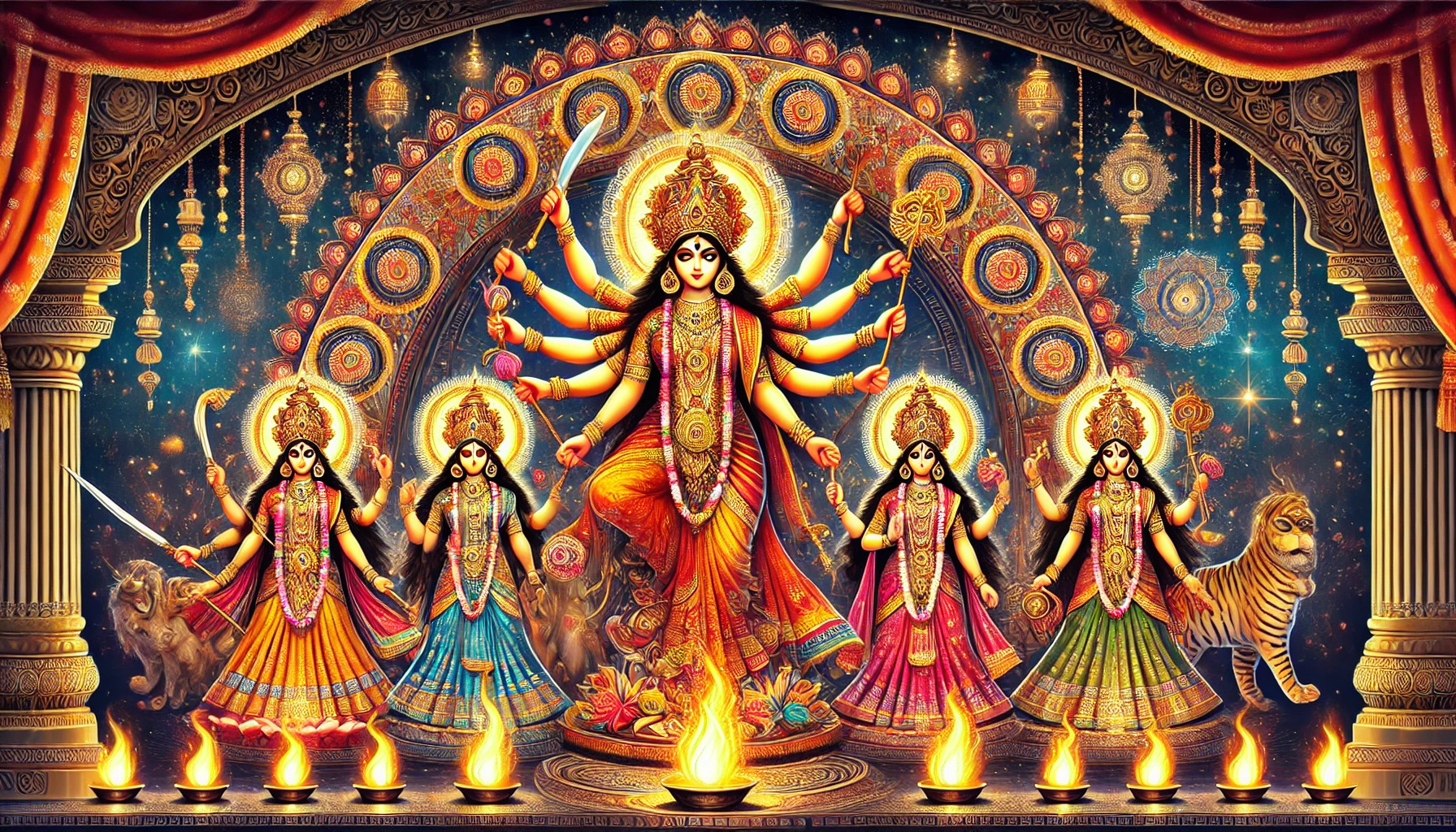As the festive season approaches, have you ever wondered what makes Navratri such a cherished celebration across India?
This nine-night celebration is all about honoring Goddess Durga and is more than just lively dances and bright outfits. It’s a deep spiritual experience too!
With roots in ancient customs, Navratri signifies the victory of good over evil, showcasing how Goddess Durga defeated the demon Mahishasura.
Each night is special, focusing on one of the nine forms of Durga, called Navadurga, each embodying unique virtues and life aspects.
Navratri has its roots in the Vedic era, where it started as a harvest festival. Over the years, it has transformed into a vibrant celebration packed with rituals, music, and dance. People fast and take part in different ceremonies to pay tribute to the goddess, asking for her blessings for strength and prosperity.
Explore Navratri: Nine Nights of Divine Celebration Through This Blog.
Let’s take a closer look at Navratri and uncover its fascinating history and importance. We’ll see how this amazing festival still inspires millions across the globe today.
Come along for this colorful adventure through one of India’s favorite celebrations!
The Historical Roots of Navratri
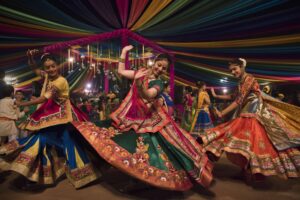
Navratri, which translates to “nine nights,” is a festival with rich historical significance in Indian culture. It dates back to ancient times when it was originally celebrated as a harvest festival.
This festival celebrates Goddess Durga, who represents the triumph of good over evil. The key story highlights the fierce clash between Durga and the demon Mahishasura, who was causing chaos in both the heavens and on earth.
The gods, unable to defeat Mahishasura, sought help from the divine feminine energy. In response, Lord Vishnu created Goddess Durga by combining the powers of all the gods, making her the ultimate embodiment of strength and courage.
She bravely battled for nine nights and ultimately triumphed over the demon on the tenth day, celebrated as Vijayadashami.
This story not only highlights the power of feminine energy but also serves as a reminder of resilience and strength in the face of hardships.
Over the years, Navratri has evolved into a vibrant celebration filled with prayers, fasting, music, and dance, uniting people from various backgrounds in devotion and joy.
Significance of Navratri in Hindu Culture
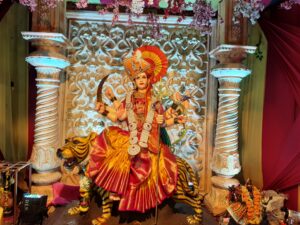
Navratri is a major celebration in Hindu culture that pays tribute to Shakti, the divine feminine energy
This nine-night festival dedicates each day to one of the nine forms of Goddess Durga; Shailputri, Brahmacharini, Chandraghanta, Kushmanda, Skandamata, Katyayani, Kaalratri, Mahagauri, and Siddhidatri. known as Navadurga. Each form highlights different life aspects and virtues like strength, knowledge, and wealth.
The first three days focus on Durga’s fierce side, which fights against negativity and evil. The next three days are all about Lakshmi, symbolizing prosperity and abundance, while the final three days honor Saraswati, the goddess of wisdom and learning.
This organized worship gives devotees a chance to reflect on their lives and seek blessings for health, wealth, and knowledge.
Plus, Navratri is a time for introspection and renewal, encouraging people to connect with their spiritual selves while joining in community celebrations.
Celebrations and Rituals During Navratri
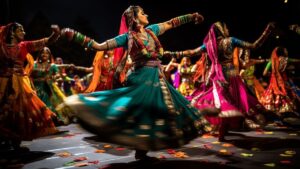
Celebrating Navratri is a lively and diverse experience throughout India . In many regions, people participate in fasting and prayer for nine days. This fasting is not only a way to show devotion but also a method to cleanse both body and mind.
Each night ends with exciting celebrations that include traditional dances like Garba and Dandiya Raas, which are particularly popular in Gujarat. These dances help bring communities together, creating a joyful atmosphere.
Homes and public areas are beautifully decorated with colorful lights and ornaments that embody the festive spirit. Temples are filled with worshippers offering prayers and performing rituals to pay tribute to the goddess.
Additionally, many cities host grand processions and cultural events that showcase local traditions through music and dance performances.
In various regions, people set up beautiful altars or “mandaps” decorated with flowers, fruits, and images of the goddess, creating a vibrant spiritual vibe. Every evening, special prayers called “aarti” take place, where devotees come together to sing hymns and light lamps in honor of Goddess Durga.
Plus, many families join in community feasts featuring vegetarian dishes, highlighting the importance of purity and sharing with friends and neighbors.
The festival ends with the immersion of idols in water or the ceremonial burning of effigies, symbolizing the triumph over evil, marking a strong finish to the nine days of devotion and celebration.
This collective effort not only brings the community closer but also highlights the cultural heritage that Navratri showcases across India.
Navdurga: The Nine forms of Durga
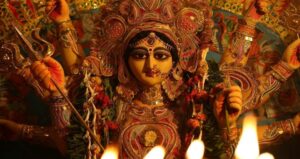
Navratri is a special time where each day is dedicated to one of the nine forms of Goddess Durga, known as Navadurga. This practice really deepens the festival experience, allowing devotees to connect with different aspects of the divine feminine.
The first day is all about Shailaputri, who represents strength and stability. She’s often shown as a young girl on a bull, symbolizing nature’s power and the need to stay grounded in our lives.
The second day Is all about honoring Brahmacharini, who represents wisdom and knowledge. She’s often depicted with a rosary and a water pot, showcasing the pursuit of spiritual understanding and a life of asceticism.
Following her, on the third day, we celebrate Chandraghanta, a symbol of beauty and bravery. She’s shown with a bell-shaped crown and is famous for her fierce protection of her followers against negative forces.
Throughout the festival, every day brings something different to the table. On day four, we have Kushmanda, representing creativity and the nurturing side of motherhood.
The fifth day is all about Skandamata, who symbolizes compassion and the essence of being a mother.
By the sixth day, we celebrate Katyayani, known for her courage and warrior-like strength to face whatever life throws our way.
On the seventh day, people celebrate Kaalratri, who stands for safety and bravery. She’s usually shown as dark-skinned and fierce, representing the strength to wipe out negativity.
The eighth day is all about Mahagauri, symbolizing purity and calmness; she’s portrayed as a stunning woman in white.
Lastly, on the ninth day, followers honor Siddhidatri, who represents success and achieving goals in life.
The Spiritual Essence of Navratri
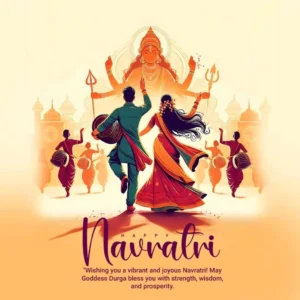
Navratri isn’t just a festival; it’s a chance for spiritual refreshment and introspection.
The nine nights represent a journey from darkness to light, both in a literal sense and on a deeper level, encouraging everyone to release negativity and embrace a more positive outlook.
Each night provides a moment for self-reflection as people engage in meditation and prayer, aiming for personal development.
Many see this time as perfect for setting goals for the upcoming year or seeking divine guidance for any challenges they might face.
The conclusion of Navratri on Vijayadashami serves as a strong reminder that good ultimately conquers evil, a message that resonates with millions around the world.
Conclusion
Each year, as we celebrate Navratri, we not only honor Goddess Durga but also reflect her incredible traits within ourselves—like strength, resilience, wisdom, and purity. This festival is a wonderful reminder that no matter how tough things get, there’s always hope for triumph over our challenges.
Through joyful gatherings filled with devotion, we build connections with others while also nurturing our spiritual growth. Whether we’re fasting or dancing under bright lights, everyone adds to the loving and positive atmosphere during these nine sacred nights. As we come together in celebration this year, let’s carry the essence of Navratri with us, embracing goodness and overcoming darkness in our lives.
The Journey of Meditation: its Origin and Timeline check out this blog for more exploration of India.

